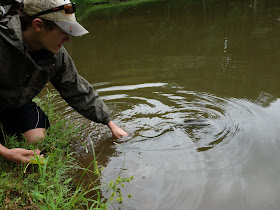I've found exactly one place in my exploration in which grass carp are targetable. It is a small park pond with a few dozen small commons and a handful of grass carp, a couple of which are absolute behemoths. The grassers don't often present themselves as viable fly targets here, but it is possible to make them show themselves by throwing out small bits of white bread. But, just because it is easy to get a grasser to eat the bread you've thrown out doesn't make it any easier to fool them and subsequently land them, it just gives you more shots. Grass carp might be the smartest fish I've ever targeted. They seem to have the ability to memorize bank structure. And if something in their frame of vision wasn't there the last time they looked at that bit of shoreline and isn't just a typical part of the environment like a fallen branch, they become less comfortable. With any other fish I've targeted, if I was wearing natural colors and not moving I had little to worry about. But with grassers, they new something was wrong and went on edge. They'd come back for the bread, but they weren't completely comfortable and it made them harder to catch. I say harder because even if they didn't spook from the sight of my hunched down 10 feet away from the bank, the leader, the rod tip, or just the fly itself put the fish on edge more than any other species I've seen. Then there was the problem of hooking up. Even if the fish grabbed the fly, it took no time at all for it to either reject it or to react so violently that it just broke clean off. Time after time I was rejected, missed the fish, or just couldn't keep them engaged. But I knew it was a game of odds, so I kept going back, over and over again.
And yesterday it payed off finally. While hiding behind a tree with my rod laying flat in the grass next to me and just the 14 foot leader over the water, I watched a grasser come up and suck my modified foam Humpy down. I picked up the rod and set the hook in one swift motion. About 15 minutes later Noah tailed the fish for me.
This grass carp was a long time coming. I was ecstatic. One of my biggest freshwater fish, #84 on my life-list: Ctenopharyngodon idella. No fish feels better than the one that takes a couple years of hard work to catch. If you don't fish non-stop like I do I'm not sure I can adequately explain it to you. Hopefully some of the photos Noah got with my new camera might do the trick.
And that's that. I got my grasser. And I don't really know that I'll be targeting them in CT for a while again, they are a pain!













WOW! GIANT! Congrats on #84, pretty darn amazing RM!
ReplyDeleteI just might hit 100 before 2018 comes to a close.
DeleteWay to go on the grasser!
ReplyDeleteThanks John!
DeleteBeautiful fish... I love the sloped forehead and color of these grassers...... Way to stay after them..... great photos, especially the release series..... Good stuff right there.
ReplyDeleteThank you!
DeleteThey are a wild looking fish. Somewhere between fallfish and tarpon I think.
That was great Rowan! Grass Carp #84 and that won't be the end. They do have a mouth for grass. Your new cam did great. Thanks for that adventure.
ReplyDeleteTie, fish, write, conserve and photo on...
Thank you.
DeleteWow! And now a question for you -- the physician's assistant at my doctor's office had her swimming pool converted to a large fish pond after a hurricane. Now the koi are so big, they're overcrowding the space. She figures some are 100 pounds or more. Any suggestions for how to corral and safely move some of them to another home? Feel free to email response, as this is really off-topic, but I will be showing her your pix, which are spectacular.
ReplyDeleteLeave them in there till Noah and I get there and we'll handle it ;)
Delete